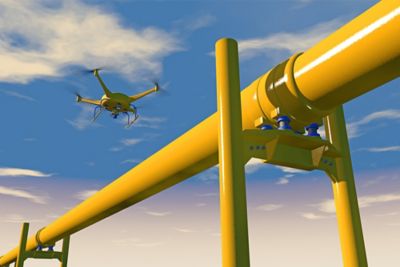-
United States -
United Kingdom -
India -
France -
Deutschland -
Italia -
日本 -
대한민국 -
中国 -
台灣
-
Ansysは、シミュレーションエンジニアリングソフトウェアを学生に無償で提供することで、未来を拓く学生たちの助けとなることを目指しています。
-
Ansysは、シミュレーションエンジニアリングソフトウェアを学生に無償で提供することで、未来を拓く学生たちの助けとなることを目指しています。
-
Ansysは、シミュレーションエンジニアリングソフトウェアを学生に無償で提供することで、未来を拓く学生たちの助けとなることを目指しています。
ANSYS BLOG
April 22, 2019
Oil & Gas Digital Twins for Prognostics & Health Management
The oil and gas industry is always searching for ways to produce energy at lower costs. To achieve this goal, the industry can apply oil and gas digital twins to various industrial equipment. Physics-based digital twins provide prognostics and health management which enables system optimization and predictive maintenance.
The industry is familiar with sensor-based digital twins that offer users a window to an asset’s current environment, service life and internal/external loads.
A drone could monitor a pipeline and transmit its conditions to a digital twin that can predict maintenance cycles or improve future designs.
A physics-based digital twin, however, provides additional insights needed to understand the performance of equipment. Digital twins take sensor data and process it through systems simulations and embedded control software that mimic the reactions of the real-world asset.
For instance, the industry can monitor a pipeline and use a digital twin to predict how erosion, corrosion, buckling and fatigue will affect the real-world asset. This data can then be used to optimize future designs, predict maintenance cycles, prevent spills, reduce downtime and improve throughput.
In other words, oil and gas digital twins, supported by Ansys physics-based simulations, are great tools to reduce operating costs and lower the risk of unplanned shutdowns.
Simulations Enable Prognostics Health Management for the Oil and Gas Industry Through Digital Twins
The oil and gas industry can use Ansys Twin Builder to create physics-based digital twins. The software simplifies 3D simulations, to preserve essential physics, and connects them in a system simulation. Once the system simulation is fed real-world data it can be called a digital twin. Since digital twins are based on simplified models, predictions can be made in seconds.
Operators can have confidence in the system because digital twins have the same Ansys simulation backbone that has supported the design of oil and gas equipment for nearly five decades.
Physics-based simulation can help the oil and gas industry maintain and predict various aspects of its operations.
The digital twin can then be connected to machine learning algorithms which predict an asset’s future performance based on historical data, sensor data and the digital twin’s output. This is how engineers use oil and gas digital twins to perform prognostics, health management and predictive maintenance.
The predictions from the machine learning algorithms can then be sent to an artificial intelligence system that controls the asset’s operations. If a digital twin and machine learning algorithms predict that a pipeline will soon spill, the artificial intelligence system can instruct a series of valves to stop flow to that area.
Thanks to simulation, the oil and gas industry is undergoing a digital transformation that includes more than just digital twins. Other aspects of the industry’s operations being improved by simulation include:
- Additive Manufacturing
- Automation
- Inspection
- Remote Operation
- Material information technology
- Virtual prototyping
- Systems engineering
To learn more, read how Ansys supports the Energy, Oil and Gas Industries, or watch the video below.
Discover how Ansys simulation software supports the energy industry.












